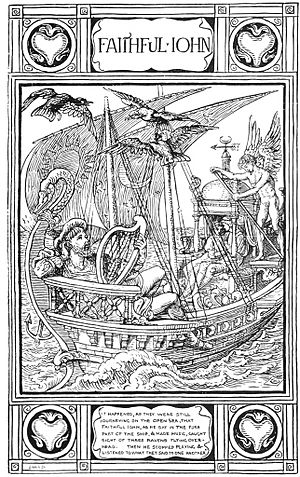Trusty John facts for kids
Quick facts for kids Trusty John |
|
|---|---|

The faithful servant stands beside his lord's bedside. An illustration of the story by H. J. Ford.
|
|
| Folk tale | |
| Name | Trusty John |
| Also known as | Faithful John, Faithful Johannes, John the True |
| Data | |
| Aarne–Thompson grouping | ATU 516 (Faithful John) |
| Region | Germany |
| Published in | Kinder- und Hausmärchen, by the Brothers Grimm |
| Related | In Love with a Statue, How to find out a True Friend, The Man of Stone, Amis et Amiles, Father Roquelaure, The Raven |
"Trusty John", "Faithful John", "Faithful Johannes", or "John the True" (German: Der treue Johannes) is a German fairy tale collected by the Brothers Grimm and published in Grimm's Fairy Tales in 1819 (KHM 6). Andrew Lang included it in The Blue Fairy Book.
It is Aarne-Thompson type 516. Others of this type are Father Roquelaure and The Raven. Antti Aarne and Stith Thompson catalogued about 500 tales under this type, of which over 200 were Irish, and the remainder, from the rest of Europe and European colonies in America. Such tales include In Love with a Statue, How to find out a True Friend, The Man of Stone, and Amis et Amiles.
Contents
Origin
The tale was published by the Brothers Grimm in the second edition of Kinder- und Hausmärchen in 1819. Their source was the German storyteller Dorothea Viehmann, from the village of Niederzwehren near Kassel.
Synopsis
In some variants, a king on his deathbed orders his servant, Trusty John, not to let his son see a certain room, which holds a portrait of a princess.
In all variants, when the new king comes to power, he forces his way into the room. Instantly, he falls in love with the princess. In Joseph Jacobs's version, her country had been at war with his, and the portrait stems from betrothal negotiations that had fallen through; but in all versions, the king does not know how to win her. Trusty John tells him to prepare a ship with all manner of rich treasure, and then either sails with it himself, or has the king sail with him, to her country. The princess is lured aboard by the goods, and the ship sets sail, carrying her off.
While they travel, John hears three ravens. One says that as soon as they reach shore, a horse will come; if the king mounts it, it will fly into the air with him, and neither will be seen again. The solution is for someone to kill the horse, but anyone who reveals this by stating it out loud would have his legs turn to stone up to the knees. The second raven says (with variations in different tellings) that the king would be killed by wine at the wedding feast if it were not dashed to the ground, or that he would be incinerated by a wedding shirt if it was not destroyed by a glove-wearing person, etc.; in all variants, whoever says so would turn to stone to his waist. The third raven says, again in different variants, that the princess would faint and die unless someone draws three drops of blood from her right breast; or a dragon would attack their bridal chamber and unless driven off, kill them. True to form, whoever states this would turn entirely to stone.

John prevents all three fates. For the first two, the king trusts that John has acted in his service; but for the third, the king decides to execute him. At the place of execution, John tells the story of the ravens and turns progressively to stone.
In time, the queen bears twin sons. The king learns that if he kill the boys and rub John's statue with their blood, he would come to life again. The king does this, and upon John's resurrection, he does the same to the boys and resurrects them. Later, John and the twins hide in a closet as the king explains what would need to be done to bring John back to test her loyalty. When the queen agrees to the sacrifice, John and the twins emerge from the door and embrace everyone. The king and queen live happily until their deaths.
Adaptations
Comics
Trusty John is a supporting character in the long-running comic book series Fables.


